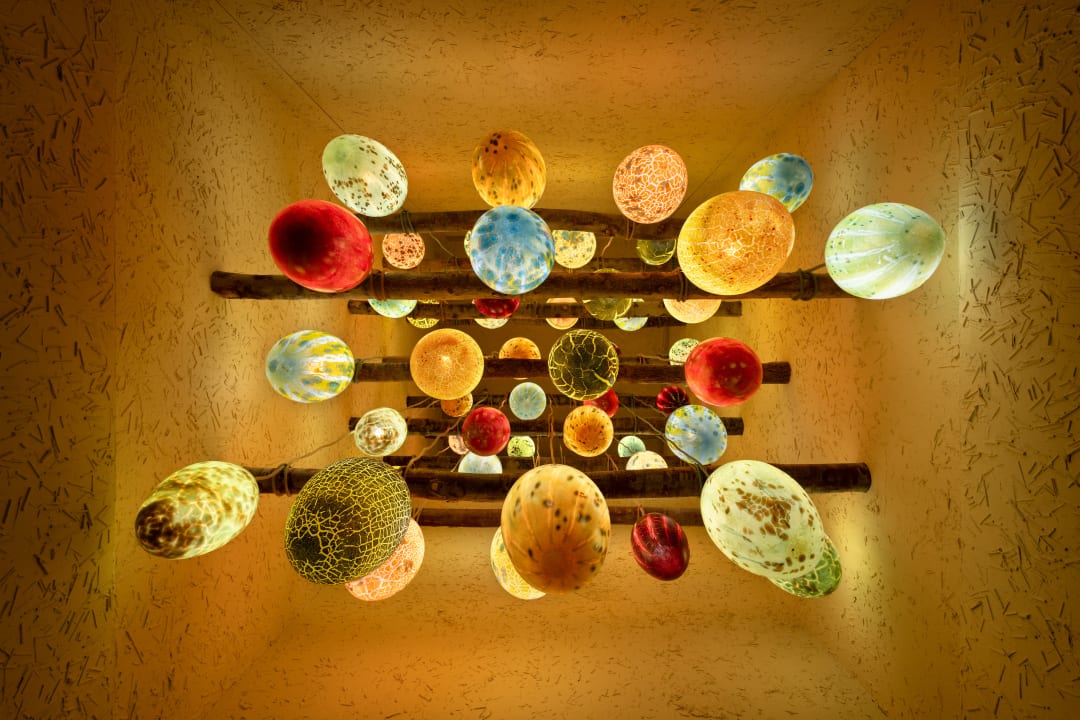This installation by the art collective Slavs and Tatars at the Islamic Arts Biennale 2025 prompts audiences to explore the link between melons and Islam.
Berlin-based art collective Slavs and Tatars is showing their mesmerising art installation Melon Mahallah (2025) at the second edition of the Islamic Arts Biennale (IAB) in Jeddah, Saudi Arabia, which runs from January 25 – May 25, 2025. The artwork features a set of around 60 blown glass lamps in the likeness of winter melons (wax gourds) that are suspended from the ceiling of a barjeel (wind tower), a traditional element in Gulf architecture meant to create cross-ventilation with the natural wind flow.
Slavs and Tatars is an art collective based in Berlin “devoted to an area east of the former Berlin Wall and west of the Great Wall of China”, as their website states, and co-founder Payam Sharifi reinforces in an interview with STIR. This is “an area of the globe that often falls through the cracks because it’s in between. It’s in between fading empires…the Russian Empire, the Persian Empire, the Ottoman Empire, the Chinese Empire”, he tells STIR, all of which have garnered greater interest in recent years. The collective’s Melon Mahallah installation speaks broadly to the significance of the melon within Central Asia and is a part of Slavs and Tatars’ ongoing efforts to sensitise global audiences to histories and cultural practices from the region.
All varieties of melon are considered to be sunnah foods, which means that they are foods the Prophet Muhammad consumed. The fruit is eaten throughout the Islamic world, especially to break the Ramadan fast. However, in Central Asia, melons take on a regional significance that needn’t be read purely in the context of Islamic culture. For example, in Uzbekistan, an annual melon festival is held in the city of Khiva—regarded as one of the oldest areas of melon cultivation in the world—stretching back at least to the 3rd century CE. The festival, Qovun Sayli, is held during the melon ripening season, typically in August and preceding the autumn harvest in September. It has its roots in Zoroastrianism, which survives to this day within majoritarian Islamic Uzbekistan, where Muslims consider wax gourds to be a sweet gift from God in an otherwise harsh winter. Qovun Sayli has parallels in Uzbekistan’s neighbouring nations, such as Mehrgon in Tajikistan, which is also rooted in Zoroastrianism, along with the more contemporary Melon Day in Turkmenistan.
The lighting of Melon Mahallah employs a seemingly simple motif that research reveals is actually a consistent symbol of divine grace, communal joy and cultural pride across Central Asia. A point of criticism is that there is little on the surface to hint at the cultural significance melons carry within the region. In fact, owing to the understated nature of the barjeel housing the melon garden, many visitors to the biennale may not even notice the artwork’s captivating lighting component. The barjeel has been designed to resemble the Kufic letter ق (Qāf), which means ‘to read’.
Melon Mahallah is housed in is ‘AlMidhallah’ (The Canopy), a section of the biennale devised as a large outdoor garden in the charbagh style, which was designed by Persian and Indo-Persian architects and is prevalent across Mughal South Asia. The garden is designed with intersecting walkways to create four quadrants, each exhibiting artworks connecting to themes of nature and community. Melon Mahallah sits in the fourth quadrant, titled ‘Congregation & Community’. Works in this section, such as Imran Qureshi’s Between Sacred Cities (2025) and Osman Yousefzada’s Arrivals (2022), enable social gathering and the exchange of ideas and experiences around Islam. Qureshi’s work is aptly positioned between two pavilions dedicated to Mecca and Medina at the art biennale. It contains a series of woven nylon mats meant to symbolise the Zubaydah Trail, a historical pilgrimage route in the Arabian Peninsula that dates back over 1000 years. Yousefzada’s art installation is composed of sixty stools featuring traditional textile work from Pakistan and references the migration of Muslims in search of work or shelter from geopolitical conflict, only to be returned daily to a state of oneness. These artworks suggest interesting poetics with Melon Mahallah as all three instigate conversations around the tangible and intangible heritage of the Islamic world. Both Between Sacred Cities and Arrivals engage traditional Pakistani handicrafts to create the seating arrangements that compose them. Meanwhile, Melon Mahallah prompts us to consider the invisible connection between the fruit and some contemporary Islamic traditions in Central Asia, along with their Zoroastrian roots.
While they are not based in the region, Slavs and Tatars’ work continues to raise interest in Central Asian culture. This comes at a time when we are seeing greater attention than ever before being given to work from West and Central Asia, and it is important that art referencing histories and practices from these regions not be conflated or subsumed under the umbrella of Islamic art. As a reading of Melon Mahallah reveals, there are fascinating regional specificities that should be considered when we think about Islam, some of which stretch further back than the religion itself.
‘Melon Mahallah’ (2025) is on view at the Islamic Arts Biennale (IAB), which runs from January 25 – May 25, 2025, in Jeddah, Saudi Arabia.
From the STIR World website.

